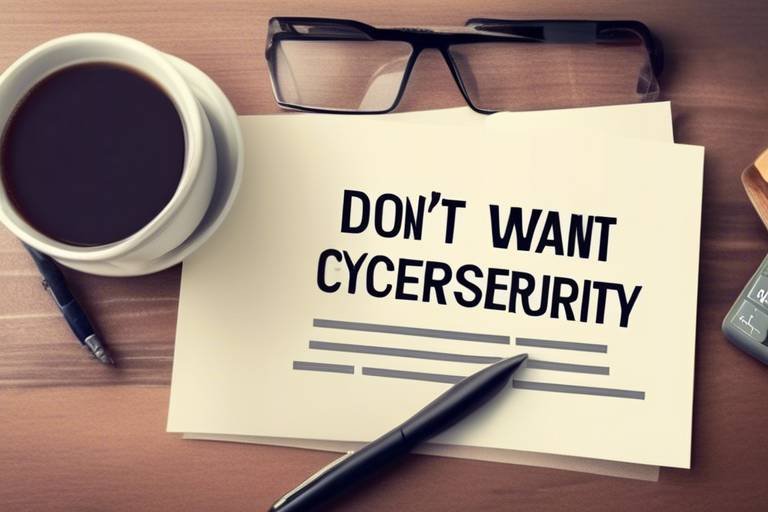The Impact of GDPR on Cybersecurity
The General Data Protection Regulation (GDPR) has fundamentally reshaped the landscape of cybersecurity across Europe and beyond. With its stringent requirements for data protection, GDPR has forced organizations to rethink their cybersecurity strategies, aligning them not only with technological advancements but also with legal compliance. This regulation serves as a wake-up call for businesses, emphasizing that protecting personal data is not just a technical issue but a legal obligation. The ripple effects of GDPR extend beyond mere compliance; they compel businesses to adopt a more robust approach to cybersecurity, ensuring that data protection is woven into the very fabric of their operations.
At its core, GDPR mandates that organizations implement comprehensive measures to secure personal data. This includes not just the technical aspects like firewalls and anti-virus software, but also operational strategies that promote a culture of data protection. For instance, organizations are now required to conduct Data Protection Impact Assessments (DPIAs), which help identify potential risks in their data processing activities. This proactive approach is akin to having a smoke detector in your home; it alerts you to potential dangers before they turn into disasters.
Moreover, the regulation emphasizes the role of Data Protection Officers (DPOs), who are tasked with overseeing compliance efforts and ensuring that data protection strategies are effectively implemented. Think of DPOs as the guardians of data security; they not only help organizations navigate the complex waters of GDPR but also serve as a bridge between the organization and regulatory authorities. This role has become increasingly critical as the penalties for non-compliance can be staggering, reaching up to 4% of a company’s annual global turnover or €20 million, whichever is greater. Such financial implications underscore the importance of integrating cybersecurity measures with GDPR compliance.
In addition to these compliance requirements, GDPR also pushes organizations to adopt advanced cybersecurity measures. The regulation explicitly states that organizations must implement appropriate technical and organizational measures to ensure a level of security appropriate to the risk. This includes the use of encryption, which transforms sensitive data into a format that is unreadable to unauthorized users. By employing encryption, organizations not only protect personal data but also demonstrate their commitment to GDPR compliance. It's like putting your valuables in a safe; even if someone breaks in, they won’t be able to access what’s inside without the right combination.
Furthermore, access control mechanisms are essential under GDPR. These measures ensure that only authorized personnel can access sensitive information, significantly reducing the risk of data breaches. Imagine a club where only members can enter; this exclusivity helps maintain security and protects the integrity of the club. Similarly, robust access control systems help organizations safeguard their data, ensuring that it is only accessible to those who absolutely need it.
In summary, the impact of GDPR on cybersecurity is profound and far-reaching. It has transformed the way organizations approach data protection, compelling them to adopt a more holistic view that encompasses both legal compliance and technical security measures. As businesses continue to navigate the complexities of GDPR, they are not only protecting their users but also fostering trust and accountability in an increasingly digital world.
- What is GDPR? GDPR stands for the General Data Protection Regulation, a comprehensive law governing data protection and privacy in the European Union.
- Why is GDPR important for cybersecurity? GDPR establishes strict guidelines for data protection, compelling organizations to enhance their cybersecurity measures to protect personal data.
- What are the penalties for non-compliance with GDPR? Organizations can face fines of up to 4% of their annual global turnover or €20 million, whichever is greater.
- What is a Data Protection Impact Assessment (DPIA)? A DPIA is a process used to identify and mitigate risks associated with data processing activities, ensuring compliance with GDPR.
- What role does a Data Protection Officer (DPO) play? A DPO oversees data protection strategies, ensures compliance with GDPR, and serves as a point of contact for data subjects and regulatory authorities.

Understanding GDPR
The General Data Protection Regulation, commonly referred to as GDPR, is a landmark piece of legislation that reshaped the landscape of data privacy and protection across Europe and beyond. Enacted in May 2018, GDPR was designed to give individuals greater control over their personal data while imposing strict guidelines on organizations that handle such data. Think of GDPR as a protective shield for your personal information, ensuring that companies treat your data with the utmost respect and care. This regulation applies to any organization that processes the personal data of EU citizens, regardless of where the organization is based, which means its reach is truly global.
At its core, GDPR is built around several key principles that organizations must adhere to. These principles include:
- Lawfulness, Fairness, and Transparency: Organizations must process personal data lawfully, fairly, and in a transparent manner.
- Purpose Limitation: Data should be collected for specified, legitimate purposes and not processed in a manner incompatible with those purposes.
- Data Minimization: Only data that is necessary for the purposes of processing should be collected.
- Accuracy: Organizations must ensure that personal data is accurate and kept up to date.
- Storage Limitation: Personal data should only be retained for as long as necessary to fulfill its intended purpose.
- Integrity and Confidentiality: Adequate security measures must be in place to protect personal data from unauthorized access, loss, or damage.
Understanding these principles is crucial for organizations aiming to comply with GDPR. Not only do they need to ensure that personal data is handled appropriately, but they must also be able to demonstrate compliance to regulatory authorities. This means organizations must implement comprehensive data protection policies and practices that align with GDPR requirements.
Moreover, GDPR introduces the concept of accountability, which means that organizations are not just responsible for compliance but must also actively demonstrate that they are meeting the regulation's standards. This includes keeping detailed records of data processing activities and being prepared to show how they comply with the regulation's principles. The potential consequences for non-compliance are severe, including hefty fines that can reach up to €20 million or 4% of the global annual turnover of the preceding fiscal year, whichever is higher. This financial risk underscores the importance of understanding and adhering to GDPR.
In summary, GDPR is not just a set of rules; it's a fundamental shift in how organizations must think about data protection. It emphasizes the need for transparency, accountability, and respect for individual privacy rights. As we delve deeper into the compliance requirements and cybersecurity measures mandated by GDPR, it becomes clear that understanding these principles is the first step toward creating a robust data protection framework.

GDPR Compliance Requirements
The General Data Protection Regulation (GDPR) establishes a stringent framework for organizations to follow, ensuring that they handle personal data with the utmost care. Compliance with GDPR isn't just a checkbox exercise; it requires a fundamental shift in how organizations view and manage data. To navigate this complex landscape, companies must adhere to several key compliance requirements that are designed to protect individual privacy rights while simultaneously safeguarding organizational data integrity.
One of the primary requirements under GDPR is the need for organizations to conduct Data Protection Impact Assessments (DPIAs). These assessments are essential for identifying potential risks associated with data processing activities. By proactively addressing privacy concerns, organizations can mitigate risks before they escalate into serious issues. DPIAs not only help in compliance but also foster a culture of accountability and transparency within data management practices.
Another critical aspect of GDPR compliance is the appointment of a Data Protection Officer (DPO). This individual is responsible for overseeing data protection strategies, ensuring that the organization adheres to GDPR principles, and serving as a liaison between the organization and regulatory authorities. The DPO plays a pivotal role in guiding the organization through the complexities of data protection laws, making their presence indispensable in any GDPR-compliant organization.
Moreover, organizations must implement appropriate technical and organizational measures to protect personal data. This includes a variety of security measures, such as encryption, access controls, and regular security assessments. The GDPR emphasizes that these measures should be proportional to the risks associated with the processing of personal data. For instance, a company that handles sensitive health information may need to adopt more stringent security protocols compared to one that processes less sensitive data.
To summarize, the key GDPR compliance requirements include:
- Conducting Data Protection Impact Assessments (DPIAs)
- Appointing a Data Protection Officer (DPO)
- Implementing appropriate technical and organizational measures
By adhering to these requirements, organizations not only comply with GDPR but also enhance their overall cybersecurity posture, ensuring that they are better equipped to handle data protection challenges in an increasingly digital world.

Data Protection Impact Assessments
Data Protection Impact Assessments (DPIAs) are not just a checkbox on a compliance list; they are a critical component of an organization's approach to data protection under the GDPR. Think of a DPIA as a safety net that helps organizations identify and mitigate risks associated with their data processing activities before they become a problem. By proactively assessing how personal data is collected, stored, and utilized, organizations can ensure that they are not only compliant with GDPR but also respecting the privacy rights of individuals.
Conducting a DPIA is akin to planning a road trip. Just as you wouldn't set out on a long journey without checking your route and ensuring your vehicle is in good condition, organizations should not embark on data processing activities without first assessing the potential impact on personal data. A well-structured DPIA allows organizations to:
- Identify potential risks to individuals' privacy.
- Evaluate the necessity and proportionality of data processing.
- Engage with stakeholders to gather insights and address concerns.
The importance of DPIAs cannot be overstated. They serve as a foundational tool for fostering a culture of accountability and transparency within organizations. When done correctly, a DPIA not only helps in compliance but also builds trust with customers and stakeholders. Imagine being a customer who knows that a company has taken the time to assess the impact of its data processing activities on your privacy; it creates a sense of reassurance that your data is in safe hands.
So, what does it take to conduct an effective DPIA? Here are the essential steps:
- Identify the need for a DPIA: Determine if your data processing activities are likely to result in a high risk to individuals’ rights and freedoms.
- Describe the processing: Clearly outline the nature, scope, context, and purposes of the data processing.
- Assess necessity and proportionality: Evaluate whether the processing is necessary for the intended purpose and if it is proportionate to the risks involved.
- Consult with stakeholders: Engage with relevant parties, including data subjects, to gather feedback and insights.
- Document the DPIA: Keep a record of the DPIA process, findings, and any decisions made.
In summary, DPIAs are not merely a regulatory requirement; they are an opportunity for organizations to take a proactive stance on data protection. By investing time and resources into conducting thorough DPIAs, organizations can enhance their data protection strategies, foster trust with users, and ultimately create a safer digital environment.
What is a Data Protection Impact Assessment (DPIA)?
A DPIA is a process designed to help organizations identify and minimize the data protection risks of a project. It is a key requirement under GDPR for certain types of data processing activities.
When should a DPIA be conducted?
A DPIA should be conducted when a data processing activity is likely to result in a high risk to the rights and freedoms of individuals, particularly when using new technologies or processing sensitive data.
Who is responsible for conducting a DPIA?
The responsibility typically lies with the data controller, but it is often beneficial to involve a Data Protection Officer (DPO) and other relevant stakeholders in the process.
What happens if a DPIA indicates high risks?
If a DPIA identifies high risks that cannot be mitigated, the organization must consult with the relevant supervisory authority before proceeding with the data processing activity.

Importance of DPIAs
Data Protection Impact Assessments (DPIAs) are not just a regulatory checkbox; they are a fundamental component of a robust data protection strategy. Imagine you're navigating a dense forest, and each tree represents a piece of personal data. Without a clear path, you risk getting lost or worse—harming the environment around you. Similarly, DPIAs help organizations identify potential risks associated with their data processing activities, ensuring that they can navigate the complex landscape of data privacy effectively.
One of the most significant aspects of DPIAs is their ability to foster a culture of accountability and transparency within an organization. When teams conduct these assessments, they are forced to confront the realities of how they handle personal data. This proactive approach not only helps in compliance with GDPR but also builds trust with customers. After all, wouldn’t you feel more secure knowing that a company is actively working to protect your personal information?
Moreover, DPIAs serve as a valuable tool for identifying and mitigating risks before they escalate into serious issues. By assessing the impact of data processing operations on individual privacy rights, organizations can implement necessary changes before any harm is done. In fact, the GDPR emphasizes the need for these assessments as a way to ensure that privacy concerns are addressed from the outset, rather than as an afterthought.
To illustrate the importance of DPIAs, consider the following key benefits:
- Risk Identification: DPIAs help organizations pinpoint vulnerabilities in their data processing activities, allowing for timely interventions.
- Enhanced Compliance: By conducting DPIAs, organizations can demonstrate their commitment to GDPR compliance, which can mitigate potential fines and penalties.
- Stakeholder Engagement: Involving relevant stakeholders in the DPIA process fosters collaboration and ensures that diverse perspectives are considered.
- Improved Data Management: DPIAs encourage organizations to adopt better data management practices, leading to more efficient operations.
In essence, DPIAs are not merely a regulatory requirement; they are a strategic advantage. By taking the time to conduct thorough assessments, organizations can not only protect individual privacy rights but also enhance their overall data governance framework. So, the next time you think about data protection, remember that a well-executed DPIA can be your guiding compass in the intricate world of GDPR compliance.
Q1: What is a DPIA?
A Data Protection Impact Assessment (DPIA) is a process designed to help organizations identify and minimize the data protection risks of a project.
Q2: When should a DPIA be conducted?
A DPIA should be conducted when a new project or process involves the processing of personal data that may pose a high risk to individuals' rights and freedoms.
Q3: Who is responsible for conducting a DPIA?
While the responsibility may vary, typically, the Data Protection Officer (DPO) oversees the DPIA process, ensuring that it aligns with GDPR requirements.
Q4: What happens if a DPIA identifies high risks?
If a DPIA identifies high risks that cannot be mitigated, the organization must consult with the relevant supervisory authority before proceeding with the data processing.

Steps in Conducting a DPIA
Conducting a Data Protection Impact Assessment (DPIA) is not just a checkbox exercise; it’s a vital process that can significantly enhance your organization’s data protection strategy. To embark on this journey, you need to follow a structured approach that ensures all aspects of data protection are thoroughly considered. Let’s break it down step by step.
First and foremost, identifying the need for a DPIA is crucial. This involves evaluating whether your data processing activities pose a high risk to the rights and freedoms of individuals. If you’re handling sensitive data or engaging in large-scale processing, a DPIA is likely necessary. Think of it like checking the weather before heading out; you want to be prepared for any storm that might come your way.
Once you’ve established the necessity of a DPIA, the next step is to describe the processing. This means detailing what data you collect, how it is processed, and for what purpose. Be as transparent as possible. It’s like drawing a map for your data journey—everyone involved should know where the data is coming from and where it’s going.
After mapping out your data flow, it’s time to assess necessity and proportionality. Here, you need to ask yourself: Is the data processing essential for achieving your objectives? Are you collecting more data than necessary? This step is about ensuring that your approach is not only compliant but also ethical. It’s akin to packing for a trip—only take what you need!
The fourth step involves consulting with relevant stakeholders. This could include your data protection officer, IT team, and even the individuals whose data you’re processing. Engaging with these parties ensures that you gather diverse perspectives and insights, making your DPIA more robust. Think of it as assembling a team for a project; collaboration often leads to better outcomes.
Finally, once all the above steps are completed, it’s essential to document your findings and decisions. This documentation should outline the identified risks and the measures you plan to implement to mitigate them. Not only does this serve as a record of your compliance efforts, but it also promotes accountability within your organization. It’s like keeping a diary of your journey; it helps you reflect on what you’ve learned and how you can improve.
By following these steps, organizations can ensure that their DPIAs are thorough, effective, and compliant with GDPR regulations. Remember, the goal is not just to tick a box but to genuinely protect the rights of individuals and foster a culture of data protection within your organization.
- What is a DPIA? A Data Protection Impact Assessment (DPIA) is a process that helps organizations identify and minimize data protection risks in their projects.
- When should I conduct a DPIA? You should conduct a DPIA whenever your data processing is likely to result in a high risk to the rights and freedoms of individuals.
- Who should be involved in the DPIA process? Involve key stakeholders such as data protection officers, IT staff, and legal advisors to ensure a comprehensive assessment.
- What happens if I don’t conduct a DPIA? Failing to conduct a DPIA when required can lead to significant fines and legal consequences under GDPR.

Role of Data Protection Officers
This article explores how the General Data Protection Regulation (GDPR) influences cybersecurity practices, compliance requirements, and the overall landscape of data protection in organizations across Europe and beyond.
GDPR is a comprehensive data protection law that sets guidelines for the collection and processing of personal information. Understanding its core principles is essential for organizations to ensure compliance and protect user data.
Organizations must meet specific compliance requirements under GDPR, including data protection impact assessments, appointing data protection officers, and implementing appropriate security measures to safeguard personal data.
Conducting Data Protection Impact Assessments (DPIAs) helps organizations identify and mitigate risks associated with data processing activities, ensuring that privacy concerns are addressed proactively in compliance with GDPR.
DPIAs are crucial for organizations to assess the impact of their data processing operations on individual privacy rights, helping to foster a culture of accountability and transparency in data management.
A structured approach to conducting a DPIA involves identifying the need for a DPIA, describing the processing, assessing necessity and proportionality, and consulting with relevant stakeholders.
Data Protection Officers (DPOs) play a vital role in ensuring GDPR compliance by overseeing data protection strategies, conducting audits, and serving as a point of contact for data subjects and regulatory authorities. They act as the bridge between the organization and the regulatory bodies, ensuring that all data protection practices align with GDPR requirements. Their responsibilities are not just limited to compliance; they also involve fostering a culture of data privacy within the organization.
One of the primary duties of a DPO is to monitor compliance with GDPR and other data protection laws. This includes ensuring that the organization conducts necessary Data Protection Impact Assessments (DPIAs) and that employees are adequately trained in data protection practices. The DPO must also keep abreast of any changes in legislation or best practices in the field of data protection, allowing the organization to adapt swiftly to new requirements.
Moreover, DPOs are responsible for liaising with data subjects, which means they handle inquiries and complaints regarding personal data. This role is crucial, as it builds trust between the organization and its customers, showing a commitment to privacy and data security. In addition, DPOs are often the first point of contact for supervisory authorities, making their role essential in managing any potential data breaches or compliance issues.
To put it simply, the DPO's role can be summarized as follows:
- Compliance Monitoring: Ensuring that the organization adheres to GDPR and other relevant laws.
- Training and Awareness: Providing training to staff about data protection and privacy policies.
- Risk Assessment: Conducting DPIAs to identify and mitigate risks associated with data processing.
- Point of Contact: Acting as a liaison between the organization, data subjects, and regulatory authorities.
In essence, a DPO is not just a compliance officer; they are a strategic partner in navigating the complexities of data protection, ensuring that organizations not only meet legal obligations but also build a robust framework for data security and privacy.
GDPR mandates that organizations implement appropriate technical and organizational measures to ensure a level of security appropriate to the risk, which includes encryption, access controls, and regular security assessments.
Encryption is a key cybersecurity measure that protects personal data by rendering it unreadable to unauthorized users, thereby reducing the risk of data breaches and ensuring compliance with GDPR requirements.
Implementing robust access control mechanisms ensures that only authorized personnel can access sensitive data, minimizing the risk of unauthorized access and enhancing overall data security in line with GDPR standards.
- What is GDPR?
GDPR stands for General Data Protection Regulation, a law in the EU designed to protect personal data and privacy. - Who needs a Data Protection Officer?
Organizations that process large amounts of personal data or sensitive data are required to appoint a DPO. - What are the penalties for non-compliance with GDPR?
Organizations can face fines of up to €20 million or 4% of their annual global turnover, whichever is higher. - How does GDPR affect cybersecurity?
GDPR requires organizations to implement strong cybersecurity measures to protect personal data, thus enhancing overall data security.

Cybersecurity Measures Under GDPR
The General Data Protection Regulation (GDPR) has fundamentally reshaped the landscape of data protection and cybersecurity across Europe and beyond. Organizations are now required to implement stringent cybersecurity measures that align with the regulation's core principles. This isn't just about ticking boxes; it's about genuinely safeguarding personal data and ensuring that individuals' privacy rights are respected. GDPR mandates that organizations take a proactive approach to data security, which includes a variety of technical and organizational measures designed to mitigate risks associated with data processing.
One of the primary requirements under GDPR is that organizations must ensure a level of security appropriate to the risk. This means that the measures implemented should be tailored to the specific vulnerabilities and threats that an organization faces. For instance, a company handling sensitive health data will have different security requirements than a retail business processing customer orders. Understanding these risks is crucial for developing effective cybersecurity strategies. Organizations must conduct thorough risk assessments to identify potential threats and vulnerabilities, which will inform the necessary security measures.
Among the key cybersecurity measures mandated by GDPR are encryption and access controls. Encryption plays a vital role in protecting personal data by converting it into a format that is unreadable without the appropriate decryption key. This means that even if data is intercepted by unauthorized users, it will remain protected. Implementing robust encryption protocols not only helps in preventing data breaches but also demonstrates compliance with GDPR's security requirements.
Access control mechanisms are another crucial component of GDPR compliance. By ensuring that only authorized personnel have access to sensitive data, organizations can significantly reduce the risk of unauthorized access and data breaches. This can be achieved through various methods, including the use of strong passwords, multi-factor authentication, and role-based access controls. For example, an employee in the marketing department may not need access to sensitive financial records, and implementing access controls ensures that this data remains secure.
In addition to encryption and access controls, regular security assessments and audits are essential for maintaining compliance with GDPR. Organizations should routinely evaluate their security measures to identify any weaknesses or areas for improvement. This can involve conducting penetration testing, vulnerability assessments, and reviewing incident response plans. By being proactive and continually assessing their cybersecurity posture, organizations can better protect personal data and comply with GDPR requirements.
To summarize, the cybersecurity measures required under GDPR are not merely a checklist of tasks to complete; they represent a comprehensive approach to data protection that prioritizes the privacy and security of individuals. By implementing strong encryption, robust access controls, and regular security assessments, organizations can create a secure environment that not only meets regulatory obligations but also fosters trust with customers and stakeholders.
- What is GDPR? GDPR stands for General Data Protection Regulation, a law that sets guidelines for the collection and processing of personal information in the EU.
- Why are cybersecurity measures important under GDPR? These measures help protect personal data from breaches and unauthorized access, ensuring compliance with the regulation.
- What are some examples of cybersecurity measures? Examples include encryption, access controls, and regular security assessments.
- How can organizations ensure they are compliant with GDPR? By implementing appropriate security measures, conducting risk assessments, and regularly reviewing their data protection strategies.

Encryption as a Security Measure
In today's digital age, where data breaches and cyber threats lurk around every corner, encryption has emerged as a frontline defense mechanism for organizations striving to protect personal data. Think of encryption as a secret code that transforms readable data into an unreadable format, ensuring that only those with the right keys can access the original information. This is particularly crucial under the General Data Protection Regulation (GDPR), which mandates stringent measures for safeguarding personal data.
When organizations implement encryption, they significantly reduce the risk of unauthorized access. For instance, if a hacker were to breach a system, the data they encounter could be rendered useless if it is encrypted. This layer of security not only protects sensitive information but also helps organizations demonstrate compliance with GDPR requirements. Essentially, encryption acts as a safety net, catching data before it falls into the wrong hands.
Moreover, encryption is not a one-size-fits-all solution. Organizations can choose from various encryption methods based on their specific needs and the sensitivity of the data they handle. Here are some common types of encryption:
- Symmetric Encryption: This method uses a single key for both encryption and decryption. It’s fast and efficient, making it suitable for encrypting large amounts of data.
- Asymmetric Encryption: This utilizes a pair of keys – a public key for encryption and a private key for decryption. It’s often used in secure communications, such as email encryption.
- End-to-End Encryption: This ensures that data is encrypted on the sender's device and only decrypted on the recipient's device, providing a high level of security during transmission.
In addition to the type of encryption used, organizations must also consider key management. Properly managing encryption keys is critical; if keys are lost or compromised, the encrypted data could become inaccessible or vulnerable. Therefore, organizations should establish robust key management policies that include regular key rotation and secure storage solutions.
Furthermore, encryption should be viewed as part of a broader cybersecurity strategy. While it is a powerful tool, it should not be the only measure in place. Organizations should combine encryption with other security practices such as access controls, firewalls, and regular security assessments to create a comprehensive defense against potential threats.
In conclusion, encryption stands as a vital pillar in the realm of cybersecurity, especially in the context of GDPR compliance. By adopting robust encryption practices, organizations not only protect sensitive data but also build trust with their users, demonstrating a commitment to safeguarding their privacy. As we continue to navigate the complexities of data protection, embracing encryption will undoubtedly be a key factor in securing our digital future.
- What is encryption? Encryption is the process of converting readable data into an unreadable format to protect it from unauthorized access.
- Why is encryption important for GDPR compliance? Encryption helps organizations safeguard personal data, reducing the risk of breaches and demonstrating compliance with GDPR requirements.
- What are the different types of encryption? Common types include symmetric encryption, asymmetric encryption, and end-to-end encryption, each serving different purposes.
- How should organizations manage encryption keys? Organizations should implement robust key management policies, including regular key rotation and secure storage to protect their encryption keys.

Access Control Mechanisms
Access control mechanisms are the gatekeepers of sensitive data, ensuring that only the right people have access to the right information at the right time. Think of them as the bouncers at an exclusive club; they check IDs, verify credentials, and make sure that only authorized individuals can enter. In the context of GDPR, these mechanisms are not just a good idea—they're a legal requirement. Organizations must implement robust access control measures to protect personal data from unauthorized access, which is crucial for compliance and safeguarding the privacy of individuals.
There are several types of access control mechanisms that organizations can implement, each with its unique benefits and challenges. The most common ones include:
- Role-Based Access Control (RBAC): This method assigns access rights based on a user’s role within the organization. For instance, a human resources manager might have access to employee records, while a marketing team member would not. This minimizes the risk of unnecessary exposure of sensitive data.
- Attribute-Based Access Control (ABAC): ABAC takes a more granular approach, allowing access based on various attributes such as user roles, resource types, and environmental conditions. For example, a user might be granted access to specific data only during business hours.
- Mandatory Access Control (MAC): In this stringent model, access rights are regulated by a central authority based on multiple levels of security. This is often used in governmental or military settings where data sensitivity is paramount.
Implementing these access control mechanisms involves several key steps. First, organizations must conduct a thorough assessment of their data to identify what needs protection and who needs access. Next, they should establish clear policies and procedures that outline access rights and responsibilities. Finally, regular audits and reviews are essential to ensure that these mechanisms are functioning as intended and that access rights are updated as roles change within the organization.
Moreover, technology plays a pivotal role in enhancing access control. For instance, multi-factor authentication (MFA) adds an extra layer of security by requiring users to provide two or more verification factors to gain access. This could be something they know (a password), something they have (a smartphone app), or something they are (biometric data). By implementing MFA, organizations can significantly reduce the risk of unauthorized access, making it much harder for malicious actors to breach their defenses.
In summary, access control mechanisms are vital for maintaining the integrity and confidentiality of personal data in compliance with GDPR. By carefully selecting and implementing the right access control strategies, organizations can protect sensitive information from unauthorized access while fostering a culture of accountability and security. Remember, the goal is not just to comply with regulations but to build trust with customers and stakeholders by demonstrating a commitment to data protection.
Q: What is the main purpose of access control mechanisms?
A: The primary purpose is to ensure that only authorized individuals have access to sensitive data, thereby protecting personal information and complying with regulations like GDPR.
Q: How often should access control policies be reviewed?
A: Access control policies should be reviewed regularly, ideally at least annually or whenever there are significant changes in the organization, such as personnel changes or updates to data handling practices.
Q: What is multi-factor authentication (MFA)?
A: MFA is a security measure that requires users to provide two or more verification factors to gain access to a system, making it more difficult for unauthorized users to access sensitive data.
Frequently Asked Questions
- What is GDPR and why is it important?
GDPR, or the General Data Protection Regulation, is a comprehensive law designed to protect personal data and privacy in the European Union. It's important because it sets strict guidelines for how organizations must handle personal information, ensuring that individuals have more control over their data and enhancing their privacy rights.
- Who needs to comply with GDPR?
Any organization that processes personal data of individuals within the EU, regardless of where the organization is based, must comply with GDPR. This includes businesses, non-profits, and even government agencies that handle personal data.
- What are the main compliance requirements under GDPR?
Organizations must fulfill several key requirements under GDPR, including conducting Data Protection Impact Assessments (DPIAs), appointing Data Protection Officers (DPOs), and implementing appropriate security measures to protect personal data. These steps are essential to ensure compliance and safeguard user information.
- What is a Data Protection Impact Assessment (DPIA)?
A DPIA is a process that helps organizations identify and mitigate risks related to data processing activities. It is crucial for understanding how data processing affects individual privacy rights and ensuring that privacy concerns are proactively addressed.
- How can organizations implement effective cybersecurity measures under GDPR?
Organizations can implement effective cybersecurity measures by employing technical and organizational strategies such as encryption, access controls, and regular security assessments. These measures help to protect personal data and ensure compliance with GDPR standards.
- What role does a Data Protection Officer (DPO) play?
A DPO is responsible for overseeing an organization's data protection strategies, ensuring compliance with GDPR, conducting audits, and serving as a liaison between the organization, data subjects, and regulatory authorities. They are essential for maintaining a culture of accountability and transparency in data management.
- What are the consequences of non-compliance with GDPR?
Non-compliance with GDPR can lead to significant penalties, including hefty fines of up to €20 million or 4% of an organization’s global annual revenue, whichever is higher. Additionally, organizations may face reputational damage and loss of customer trust.
- How does encryption help in GDPR compliance?
Encryption protects personal data by transforming it into a format that is unreadable to unauthorized users. This security measure significantly reduces the risk of data breaches and helps organizations comply with GDPR's requirement to implement appropriate security measures.
- What are access control mechanisms and why are they important?
Access control mechanisms are security measures that restrict access to sensitive data to authorized personnel only. They are crucial for minimizing the risk of unauthorized access and ensuring that personal data is adequately protected in accordance with GDPR standards.



















